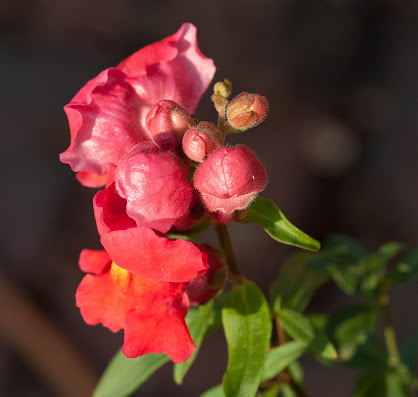A to Z challenge 2023 – B is for . . .
My
theme for this challenge is Nature in all much of her wonderful
diversity. My posts will reflect the fact that I am resident in the south of
England.
All photographs in this post are the property of the writer.
I grow herbs for culinary purposes, but my main purpose is to allow them to flower. The masses of tiny flowers attract bees and other pollinators.
Rosemary (Salvia rosmarinus)
Rosemary (Salvia rosmarinus) in flowerBasil is not a hardy plant, but will grow outdoors in what passes for summer in England. It requires sun, shelter and water. It can also be grown indoors on a sunny windowsill.
It is reputed to be an excellent companion plant for tomatoes because its strong smell repels pests like aphids and spider mites and also deters caterpillars. Slugs and snails are attracted to the soft leaves, so growing it in a container rather than in the soil can reduce the risk of it being destroyed.Flowering reduces the quality of the leaves but provides pretty white or purple flowers, beloved of bees and other nectar-gathering insects.
My second B is for Blueberry (Vaccinium sect. Cyanococcus)
We have a productive blueberry bush in our garden.
. . . and many birds (and squirrels, mice and rats) enjoy the fruit that follows. The autumn foliage is bright and colourful, particularly on a drizzly, dank day.
Sweet, juicy berries to be enjoyed on their own, or with yoghourt, or with porridge
Blueberries are rich in vitamin C, low in sugar and are a good source of fibre. Alongside several ‘may’ statements (may help prevent heart disease, may help maintain eye health, may alleviate UTIs, et cetera) there is a rider. Blueberries, like some other fruits, such as apples, peaches and raspberries, contain chemicals called salicylates, to which some people are sensitive and which may cause (there’s that ‘may’ again) allergic reactions, including skin rash or swelling.
As ever, common sense is the great protector – if in doubt, don’t!
Salicylates are natural chemicals produced by plants to protect themselves against disease and insects. Extracts from salicylates have been used for thousands of years in medicine. The most common is salicylic acid, known to most of us as aspirin.
My final B is for Bunny mouth (Antirrhinum majus)
A flower that reminds me of childhood is the bunny mouth. I never tired of squeezing the sides of the flower to make the little mouth open. Some people know these flowers as snapdragons or dragon flowers but their 'official' name is Antirrhinum majus. They have also been called lion’s-mouth, bonny rabbits, calf-snout, toad’s mouth, bulldogs and lions’-snap.
They are native to rocky areas of the Mediterranean, the United States and North Africa.
Thomas Jefferson (1743 – 1826) first noticed snapdragons at his home in Shadwell in 1767 and subsequently grew the seeds and recorded their growth.
Primarily grown for cutting, edible oils have been extracted from the seeds and used like butter in Russia. The leaves and flowers are believed to possess anti-inflammatory properties and have been used in poultices for ulcers. The flowers are edible and make a colourful addition to salads or desserts.
In German folklore, a bunch of antirrhinums would be hung near a baby, believing that it would grow up unafraid of evil spirits. This reflects the belief among Romans and Greeks that the plant would protect them from witchcraft.
For the Victorians, a bouquet of antirrhinums was an indication of a forthcoming proposal. To further the chances of this happening, a snapdragon hidden in the clothing was thought to make a person fascinating and alluring. Perhaps they were hedging their bets when, in the Language of Flowers, they decided that snapdragons meant either deception or graciousness, a case of ‘You pays your money and takes your choice.’






.jpg)











There so very many varities of Basil we could grow in Greece (where it has religious significance rather than being a culinary herb) that I wonder if there wasn't at least one we could grow in sheltered outdood summer sun here. I should have brought some cuttings of the perennial ones. The smell is divine.
ReplyDeleteIt's interesting to note that there are many varieties of basil. I must look out for different ones.
DeleteThat's a great selection of bees and 'b's. I'd never heard a snapdragon called a 'bunny mouth' before! Basil grows well on my kitchen window sill in Aberdeen but I doubt it would survive outdoors in Britain's chilliest city!
ReplyDeleteCheers, Gail.
It survives outside in the summer in the soft south, but can't withstand the cold.
DeleteWhat I learnt that interested me:
ReplyDeleteWhat a spearmint plant looks like.
That rosemary is a salvia.
What chives flower looks like.
That there is a lot of history to antirrhinums.
Facts for a pub quiz, maybe?
DeleteMy indoor basil from last year is just about hanging on. I may try feeding it perhaps.
ReplyDeleteThey do need a bit of nursing - that's probably why mine give up!
DeleteBeautiful photos. I'll plant basil with my tomatoes next year.
ReplyDeleteRonel visiting for B:
My Languishing TBR: B
Birds of Faerie
I hope it works for you :-)
DeleteAnother post full of interesting facts and wonderful photos.
ReplyDeleteI don't think I've ever seen basil flowers, or blueberry ones for that matter. Finally, I've never heard Antirrhinum majus called Bunny mouth, which I think is rather sweet. They are called Leeuwebekjes (Lion's mouth) in Flemish! xxx
Seen from certain angles they do look like little lions' heads.
DeleteThis comment has been removed by a blog administrator.
ReplyDeleteI must have had a bunch of antirrhinums hung by my cradle as I am unafraid of pretty much everything.
ReplyDeleteYou're just naturally brave!
DeleteI'm not all that fond of basil, sadly, but Beth loves it.
ReplyDeleteI call antirrhinums snapdragons but I love the name bunny mouth too. xx
I've never called them snapdragons, but I do like that name.
ReplyDeleteAn excellent selection of herbs -- many of which I grow in my community garden plot (allotment) in New York City. In fact, your post reminds me that I need to get started preparing the soil for garden season.
ReplyDeleteSo starts the race with Nature, encouraging things you want, trying to discourage others.
DeleteI grew blueberries for a while. The only way I could compete with the birds for eating them, though, was to put a net over them.
ReplyDeleteBirds don''t understand the concept of share and share alike . . .
ReplyDelete